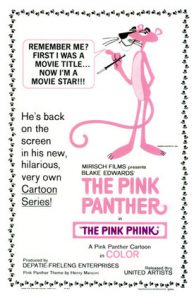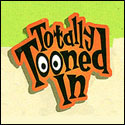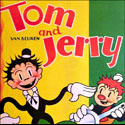 This year’s winner was a good classy Hollywood cartoon – and I think it was the wisest choice. The Pink Phink wasn’t just another cartoon. It was Freleng’s timing expertise at the height of his powers. It was a new look and feel that made sense for movie-going audiences of the 1960s. It was a rare Hollywood cartoon that wasn’t embarrassing – which almost all the studio releases were becoming at this point.
This year’s winner was a good classy Hollywood cartoon – and I think it was the wisest choice. The Pink Phink wasn’t just another cartoon. It was Freleng’s timing expertise at the height of his powers. It was a new look and feel that made sense for movie-going audiences of the 1960s. It was a rare Hollywood cartoon that wasn’t embarrassing – which almost all the studio releases were becoming at this point.
DePatie-Freleng Enterprises in 1964, ’65 and ’66 (heck, through 1970) actually defined a new style for theatrical cartoons in the 1960s – in the same way Warner Bros. (and Bugs Bunny) embodied the 40s, and UPA (Magoo) epitomized the 50s. They blazed a new path. They were popular – and garnered fans. They had very few imitators, and that’s a shame. Most other Hollywood-affiliated animation studios ignored what D-FE were doing – and slowly closed up shop. DePatie Freleng itself hung it up – creatively – in the 1970s, but still turned out some solid work – especially in commercials, movie titles and on TV specials.
This week: 1964
 The actual nominees were:
The actual nominees were:
CHRISTMAS CRACKER (National Film Board of Canada) Norman McLaren, Grant Munro, Gerald Potterton, Jeff Hale [View]
HOW TO AVOID FRIENDSHIP (Rembrant) Gene Deitch
NUDNIK No. 2 (Paramount) Gene Deitch [View]
And the Oscar went to:
THE PINK PHINK (DePatie-Freleng; United Artists) Friz Freleng, director. [View]
On April 5th, 1965 at the Santa Monica Civic Auditorium, presenter Merle Oberon presented the Oscar to producer David H. DePatie and director Friz Freleng. No video is available of the awards – so we might as well watch the cartoon:
And so we continue our weekly research into what other cartoons were submitted to the Academy for Oscar consideration but failed to make the cut. In 1964, submitted, screened, but NOT nominated were:
 BREAKING THE HABIT (Modern Talking Picture Service) Henry Jacobs, John Korty
BREAKING THE HABIT (Modern Talking Picture Service) Henry Jacobs, John Korty
DEATH AND SUNRISE (Brandon Films) Eyvind Earle
A FINNISH FABLE (Cinema 16) Carmen D’Vino
FIX THAT CLOCK (Paramount) Seymour Kneitel
GADMOUSE – THE APPRENTICE GOOD FAIRY (20th Century Fox-Terrytoons) Ralph Bakshi
THE HAT (Storyboard) John and Faith Hubley
LITTLE BOY BAD (Columbia) Sam Weiss
ROOF TOP RAZZLE DAZZLE (Universal-Lantz) Paul J. Smith
THREE LITTLE WOODPECKERS (Universal-Lantz) Sid Marcus
Here’s the documentation:

With these posts we ask that you put yourself in their place – which films would you have nominated? Which cartoon should have won? For your edification and viewing pleasure, here are the cartoons the Academy screened which didn’t make the cut (unfortunately not all of them are online). Enjoy the show!
BREAKING THE HABIT (Modern Talking Picture Service) Henry Jacobs, John Korty
 Breaking the Habit is currently being restored by the Academy Film Archive.
Breaking the Habit is currently being restored by the Academy Film Archive.
This was an anti-smoking short, which which is described as having “deadpan dialogue with a minimalist animation style”.
In 1964, John Korty opened a studio in Stinson Beach, CA and made several shorts and three feature films before focusing mainly on documentary filmmaking. In 1977 Korty won the Feature Documentary Oscar for Who Are the Debolts and Where Did They Get Nineteen Kids?. His 1984 animated feature Twice Upon A Time, produced by George Lucas, has recently seen a revival of interest – and has become a bonified “cult” film.
DEATH AND SUNRISE (Brandon Films) Eyvind Earle
Death and Sunrise is one a several independent shorts created by famed Disney background painter Evind Earle (Sleeping Beauty) during the 1960s. As you’d imagine, the animation is minimal but the graphics are gorgeous. Essentially this is a western – a sheriff pursuing and having a shoot-out with a gang of outlaws – told via Earle’s incredible paintings, camera pans, and an exciting musical score.
Lost for many years, Asifa-Hollywood will be restoring Death and Sunrise this year. Experimental in nature – but in line with the Paul Julian films (like Hangman) – the film was released in 1962. It was submitted to the Academy in 1964. By permission of Evind Earle Publishing LLC, here is an excerpt of the last two minutes of the film:
(c) Evind Earle Publishing LLC
A FINNISH FABLE (Cinema 16) Carmen D’Avino
Let’s see if I understand this one – Experimental animator Carmen D’Avino creates a stop-motion/pixilation “garden of Eden” populated with life size mannequins who…
Oh, who am I kidding? I have no any idea what’s going on here. It’s “experimental” and interesting, but makes no narrative sense. You can watch the film here. “Time For Crayfish!”

FIX THAT CLOCK (Paramount) Seymour Kneitel
Fix That Clock is a Paramount ‘Swifty and Shorty’ cartoon featuring Eddie Lawrence, with an original story by Eddie Lawrence. Not to be confused with Lawrence’s Fix Your Watch, which was made into a Noveltoon called Without Time Or Reason in 1962. This cartoon has Swifty and Shorty as clock repairmen fixing a huge clock on what looks like the Paramount building in Times Square.
I love Eddie Lawrence, but the thing about him is that he’s an audio comedian. His monologues and skits are hilarious. Radio and records were his perfect medium. Making literal what Lawrence conjures in the mind really isn’t as funny – and when the animation is limited, there’s no point.
GADMOUSE – THE APPRENTICE GOOD FAIRY (20th Century Fox-Terrytoons) Ralph Bakshi
This might be the first cartoon Ralph Bakshi directed at Terrytoons. He also animated all of it himself – and designed the characters. It’s certainly one of his best – and if it had remained a one-shot, I think I’d admire it more than I do. But alas, its the first of the Terrytoon Sad Cat cartoons – a weak series of theatrical shorts despite this intriguing start.
The first 20 seconds are as radical a visual shift for the studio as I’d imagine Gene Deitch’s arrival caused ten years earlier. Sad Cat is a neurotic Cinderella-like cat with two mean step-brothers. Gadmouse, the apprentice good fairy sends Sad Cat to the ball and makes a dancer out of him – but he ends up still subservient to his brothers in the end.
Submitting this film was understandable. But this was the year of another cat, a cooler one – in pink.
THE HAT (Storyboard) John and Faith Hubley
John and Faith Hubley made one personal film each year. These were meant to be non-commercial experiments, but sometimes they met with unexpected popularity and awards at numerous film festivals (not to mention several Oscar nominations and wins).
The Hat, however, falls flat. This 18-minute short covers some of the same ground as 1962’s The Hole with improvised dialogue, the Hubley’s now familiar sketchy style art, and a didactic anti-war message. Here, two border guards (voiced by Dizzy Gillespie and Dudley Moore) discuss their differences, their similarities, and the nature of war – all brought on when one of them drops his hat on the other side of his border.
Shamus Culhane, Bill Littlejohn and the “Tower 12 Group” (Chuck Jones animators?) do the animation under John and Faith’s art direction. More nominations and wins for the Hubley’s in the years to come – just not this time around.
LITTLE BOY BAD (Columbia) Sam Weiss
Sam Weiss was a production designer and animation director with a career that dates back to Crusader Rabbit and Mr. Magoo, and who flourished in the early 1960s with his own small studio, mainly producing industrials.
I know nothing about Little Boy Bad despite my best efforts to research it. It was picked up by Columbia where it was sold to theaters as a “One-Reel Special” (as opposed to simply a cartoon short – this was the same status that Pintoff’s The Critic received).
The Academy screened it and it wasn’t nominated. If any readers have any leads to seeing this film – or any information about it – please write in and let us know.
UPDATE: In the Comments Section below, Yowp provides evidence that this was an unsold TV pilot.

ROOF TOP RAZZLE DAZZLE (Universal-Lantz) Paul J. Smith
These 1960s Lantz cartoons… I’m not a fan. Larry Tremblay found a copy of this cartoon for us to embed below. I asked Thad Komorowski to take a look. Says Thad:
It’s a Beary Family cartoon almost entirely animated by Les Kline. That’s enough to scare off any seasoned viewer, and I’m sure it provided the noise drive-ins needed while patrons went to get a snack or use the bathroom. Not much else to say…
THREE LITTLE WOODPECKERS (Universal-Lantz) Sid Marcus
Thad K. also found a copy of this cartoon for us to view – and here is his guest commentary of it:
Inexplicably chosen by Walter Lantz as his personal favorite, it’s a nice example of Sid Marcus getting the most bang out of a lack of bucks. Art Davis shows that limited animation doesn’t have to be stiff by using just a few more drawings, and he gets some some funny cycles and poses throughout. It was nice they made the effort to bring back our recently departed friend June Foray to reprise her role of Splinter and Knothead, rather than use Gracie. Personally, I’m more partial to the following year’s sequel, Rough Riding Hood, which also features the Frank Fontaine wolf (voiced by the irreplaceable Daws Butler).
(Thanks to Thad Komorowski and Larry Tremblay)


 Jerry Beck is a writer, animation producer, college professor and author of more than 15 books on animation history. He is a former studio exec with Nickelodeon Movies and Disney, and has written for The Hollywood Reporter and Variety. He has curated cartoons for DVD and Blu-ray compilations and has lent his expertise to dozens of bonus documentaries and audio commentaries on such. Beck is currently on the faculty of CalArts in Valencia, UCLA in Westwood and Woodbury University in Burbank – teaching animation history. More about Jerry Beck [
Jerry Beck is a writer, animation producer, college professor and author of more than 15 books on animation history. He is a former studio exec with Nickelodeon Movies and Disney, and has written for The Hollywood Reporter and Variety. He has curated cartoons for DVD and Blu-ray compilations and has lent his expertise to dozens of bonus documentaries and audio commentaries on such. Beck is currently on the faculty of CalArts in Valencia, UCLA in Westwood and Woodbury University in Burbank – teaching animation history. More about Jerry Beck [








Of course the Pink Panther made his debut in the titles of Blake Edwards’ classic comedy of the same name that year.
One animated short that should have nominated was Walerian Borowczyk’s’ Les Jeux Du Angles’ (The Joy of Angels). Perhaps the Academy thought it was too abstract to be nominated.
The correct title is “The Games of Angels.” I’ve seen that film, a grim, abstract masterpiece, but Hollywood wasn’t ready in 1964 for an animated cartoon on the subject of concentration camps, allegorical or not.
Certainly true Tom, the film was certainly ahead of the pack with its theme.
https://youtu.be/mq7ugNkM7Cg
I see a resemblance between “Death and Sunrise” and the anti-smoking ad “Out of the West” in background, though the latter had even more limited animation.
I guess my only complaint about the Pink Panther is that the Academy chose to nominate THE PINK BLUEPRINT two years later, which is enjoyable but too much of a copycat film in basic plot. There were many others that were different enough to nominate. Of course, I am sure a few of them will be covered as “not considered” in coming weeks.
As I listened to the BEARY FAMILY cartoon, I could only think that some of the gags were extensions of those in a very good LAUREL AND HARDY live action short from the Hal Roach studios called “HOG WILD”…and I see your point about the SWIFTY AND SHORTY cartoon. Almost all that dialogue would have been even better as a stand-up routine.
Loved The Pink Phink, which was the cornerstone of the DFE animation empire and became one of the powerhouses of animation.
One cartoon that I’d wished were considered for the Oscar for Best Aminated Short of 1964 was Warner Bros’ Bartholomew Vs The Wheel. It’s the story of a dog named Bartholomew (as told from the POV of his young owner) who had a very traumatic experience as a pup, getting his tail run over by a toddler riding a scooter, resulting his bitter hatred with anything with wheels. This results with him chasing an air cargo plane, capturing the tire, and winding up somewhere in the Middle East!
Loved how Mel Blanc used his ‘Dino the Snorkasarus’ voice from The Flintstones as Bartholomew’s puppy voice.
And since no one asked (or cares), here are other cartoons I love from 1964 that, in my humble opinion, should have gotten a nomination for Best Animated Short…
Kisser Plant (Terrytoons)
Oil Through the Morning (Terrytoons)
Woody’s Clip Joint (Universal/WLP)
Roamin’ Roman (Universal/WLP)
Ski-Napper (Universal/WLP)
Dumb Patrol (Warner Bros)
Dr Devil and Mr Hare (Warner Bros)
And
False Hare (Warner Bros)
Philadelphia Inquirer, Feb. 23, 1964:
Actor John Brinkley, a folk-singer on the side, sat down and wrote a song called “Little Boy Bad,” about a bad lad who comes to a good end, but only after he learns that the Golden Rule sure beats kicking people around. Instead of submitting it to a song publisher, John took it over to Screen Gems. The studio bought it (for $3500) and will use it as the theme song for a series (the pilot of which is now under way) called “Little Boy Bad.”
That explains it – Little Boy Bad wasn’t a Sam Weiss independent short – but a Screen Gems TV pilot! Sony must have it in their vaults (I hope). Like The Astro-mutts last week – No wonder there is no trace of it anywhere.
This is why I love doing these posts – it’s digging out information that has completely fallen through the cracks. Thanks Yowp!
I’m actually shocked Screen Gems did something themselves post 1946. Anyone know if Screen Gems did more failed TV pilots beside Little Boy Bad?
Of the Sid Marcus-directed films, DEEP FREEZE SQUEEZE was certainly worth a nomination. Its starvation takes are unforgettable! Other Sid-Art cartunes would have been worth a look thanks to their “someone tried” factor which was otherwise uncommon at Lantz.
WAR AND PIECES, with Maurice Noble guiding his old friend Dave Rose on layouts, may be the best-looking post-’59 RR even without its Oriental art.
But THE PINK PHINK hands-down deserved its Oscar. I saw it in 1965. Fresh and funny throughout, it convinced this then- young writer that the animated cartoon industry was starting a good rejuvenation!
“Without Time Or Reason” from 1962 was actually a pretty good cartoon, but mainly because it was so heavy in Lawrence’s dialogue it offset the extremely limited Paramount budgets of the period. The problem with “Fix that Clock” any most of the other ones done when “Swifty and Shorty” became a series was not enough fast talking, which meant the animation then had to carry the cartoons. It couldn’t.
Actually, the Pink Panther’s very first appearance was in the trailer of the feature and features original animation.
Thanks for the correction P.A..
You can check that out on the newly-released Shout! Faxtory collection of the complete Peter Sellers Pink Panther movies (Including the Revenge of the Pink Panther, which MGM have purchased the rights of it recently, mainly to own it, just like the two non-EON Bonds they own)!!!
I remember Frank Fontaine as “Crazy Guggenheim” on the old Jackie Gleason variety show. It seemed as though everybody wanted to mimic him. In addition to Daws Butler in “Three Little Woodpeckers,” characters with Fontaine voices include Deputy Dawg, by Dayton Allen, and Pete Puma, by the great Stan Freberg.
Frank was going to voice a rhino named Rocky in “The Jungle Book”(1967), but Walt himself decided to drop the scene as he felt the film already had enough perils scenes and didn’t want one peril lead to another.
Yup, and Yowp profiled Frank here:
http://tralfaz.blogspot.com/2016/11/the-not-so-crazy-frank-fontaine.html
One of the things that helped Frank Fontaine become a “name” was the fact that he could sing–in a voice quite unlike that he used for Crazy Guggenheim.
Fontaine liked to sing the old songs. He may have been one of the few singers of the early 1960’s who could sing “My Melancholy Baby”, and mean it!
Even though Gleason recorded a bounty of mood-music albums for Capitol, it was ABC-Paramount that snagged Fontaine.
Several good-selling albums followed. The clog junk piles to this very day!
A couple of years later, Jim Nabors would also demonstrate this talent for singing in a voice quite unlike that used for the speaking voice of his best-known character.
Walter Lantz himself also did a few of those Doc the Cat and Champ the Bulldog shorts a few years earlier, with Dallas McKennon doing the Frank Fontaine voice. That was also done for two Gumby TV shorts also around this timne, also by McKennon for Art C lokey, both seasonal:
“Witty Witch” as monster
“A Pigeon in a Plum Tree” as Prince Harold
Additional Leo De Lyon did that voice for HB as Top Cat’s buddy “Brain”. And of course Daws at his home studio Hanna-Barbera used it for both Mr.Jinks and that wacky lion Huckleberry Hound hunted, in the 1958-1959 debut season “Lion-Hearted Huck” and 1959-1960 “Somebody’s Lion”.
And in those Lantz cartoonsa with McKennon doing the Fontaine bulldog Champ, Paul Frees did Doc the cat (see my last reply.:0))
And these three Kroffts puppets Sparky firefly from BUGALOOS, Raumchy Rabbit in a liddville and the title character of Sigmumd/ as voiced by the great imitator actor Walker Edmiston
Did Terrytoons get a jump on the other studios in adapting to Xerography? Don’t believe I’ve ever seen a non-Disney production use that process prior to 1965 (when Hanna-Barbera and DePatie-Freleng, among others, began employing it).
Disney first used xerox cels in GOLIATH II (which was nominated in 1960) – and of course used xerox in all their features since 101 DALMATIANS (1961). But you are right – I can’t think of any theatricals by other (non-Disney) studios before Terrytoons.
Then at least that’s one thing I guess we can credit Terrytoons with (being the first non-Disney operation to employ the use of Xerography on cels). I recall Paramount went the same way during their last batch of cartoons but I could be wrong. WB might’ve kept inking cels up to the end in the late 60’s though there is a shot in “Rabbits Stew & Rabbits Too!” that could’ve been done in xerox featuring a car moving towards the camera from the horizon. For a golden age studio, Walter Lantz Productions was probably the LAST to use inking to the very end in the early 70’s.
I always liked the early Pink Panther cartoons best. They were one of few examples of good, humorous cartoons with what seemed to be a limited budget. “Pink Pajamas” is another short that could have been a contender.
Noticed the video link to “The Hat” doesn’t seem to be working right now, here’s where to watch it otherwise, though the poster does that odd thing of repeating an earlier section of the video to make it longer (I’m guessing it’s a way to thwart YouTube’s logarithms from deleting it).
https://youtu.be/zns2rB6P4_s
Thanks Chris.
I thought Jerry liked the Sid Marcus Lantz shorts. I consider those the last good cartoons at the studio. There were better than the shorts by you know who (seriously, Smith should’ve left “The Beary Family” alone after Hannah left the studio). Besides, I expected Lantz tried to get “Three Little Woodpeckers” nominated. I liked the short, but I didn’t get the last gag where Woody gives the wolf a pie full of angry baby woodpeckers. A bit random if you asked me.
THREE LITTLE WOODPECKERS is very funny. The gag with the wolf using the log on a bike is one of my favorites.
ROOF TOP RAZZLE DAZZLE wasn’t bad at all, plenty of good sight gags.
Gadmouse the Apprentice Good Fairy was the first theatrical short Bakshi directed for Terrytoons, but he had previously directed (and animated) a few Deputy Dawg cartoons for television. I believe this is one of his:
Save Ol’ Piney – https://www.youtube.com/watch?v=4N8U82lN60A
I wish I knew more about Sid Marcus. There doesn’t seem to be a lot of information about him around.
The complete version of THE HAT with ending attached: https://archive.org/details/thehatisthiswarnecessary
It’s A Shame,MGM didn’t submit some of Chuck Jones’ Tom & Jerry cartoons that were released this year,as well as WB not submitting any Looney Tunes and Merrie Melodies shorts for consideration as well,due to Warner closing down the Termite Terrance division last year. Here’s some of the best standouts that MGM and Warner Bros. should’ve submitted that would have been considered for an Acadamy Award-
Tom and Jerry:
-The Cat Above and The Mouse Below
-Snowbody Loves Me
-Tom-Ic Energy
Looney Tunes & Merrie Melodies:
-Senorella and The Glass Hurache(Hawley Pratt’s Really Funny Mexican Take on Cinderella,which was the last cartoon produced at the original Warner Bros Cartoons division before Warner shuttered the studio in 1963)
-Hawaiian Aye-Aye(The Final Rivalry between Tweety and Sylvester,until 31 years later in The Sylvester and Tweety Mysteries)
-Pancho’s Hideaway(One of the first Warner Bros. shorts made by DePatie-Freleng,A great wonderful attempt made by Freleng and Pratt at pairing Speedy Gonzales with a new villian,who is a Mexicanized version of Yosamite Sam(Pancho Vanilla))
-Nuts and Volts(Another great Speedy Gonzales cartoon)
-War and Pieces(A Very Fantastically Great Wile E. Coyote-Road Runner Cartoon by Chuck Jones with an Asian Ending)